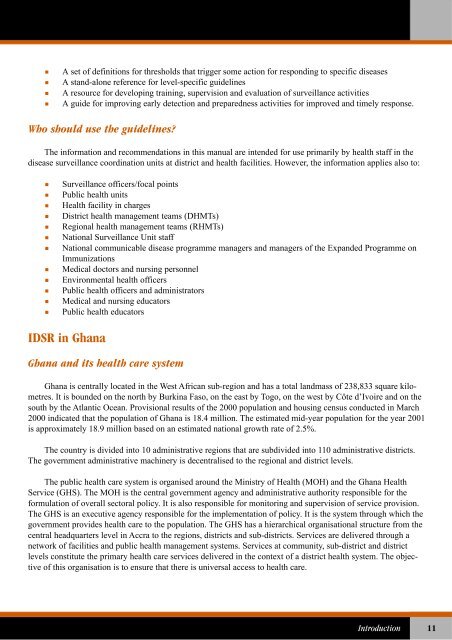Technical Guidelines for Integrated Disease Surveillance ... - PHRplus
Technical Guidelines for Integrated Disease Surveillance ... - PHRplus
Technical Guidelines for Integrated Disease Surveillance ... - PHRplus
You also want an ePaper? Increase the reach of your titles
YUMPU automatically turns print PDFs into web optimized ePapers that Google loves.
A set of definitions <strong>for</strong> thresholds that trigger some action <strong>for</strong> responding to specific diseasesA stand-alone reference <strong>for</strong> level-specific guidelinesA resource <strong>for</strong> developing training, supervision and evaluation of surveillance activitiesA guide <strong>for</strong> improving early detection and preparedness activities <strong>for</strong> improved and timely response.Who should use the guidelines?The in<strong>for</strong>mation and recommendations in this manual are intended <strong>for</strong> use primarily by health staff in thedisease surveillance coordination units at district and health facilities. However, the in<strong>for</strong>mation applies also to:<strong>Surveillance</strong> officers/focal pointsPublic health unitsHealth facility in chargesDistrict health management teams (DHMTs)Regional health management teams (RHMTs)National <strong>Surveillance</strong> Unit staffNational communicable disease programme managers and managers of the Expanded Programme onImmunizationsMedical doctors and nursing personnelEnvironmental health officersPublic health officers and administratorsMedical and nursing educatorsPublic health educatorsIDSR in GhanaGhana and its health care systemGhana is centrally located in the West African sub-region and has a total landmass of 238,833 square kilometres.It is bounded on the north by Burkina Faso, on the east by Togo, on the west by Côte d’Ivoire and on thesouth by the Atlantic Ocean. Provisional results of the 2000 population and housing census conducted in March2000 indicated that the population of Ghana is 18.4 million. The estimated mid-year population <strong>for</strong> the year 2001is approximately 18.9 million based on an estimated national growth rate of 2.5%.The country is divided into 10 administrative regions that are subdivided into 110 administrative districts.The government administrative machinery is decentralised to the regional and district levels.The public health care system is organised around the Ministry of Health (MOH) and the Ghana HealthService (GHS). The MOH is the central government agency and administrative authority responsible <strong>for</strong> the<strong>for</strong>mulation of overall sectoral policy. It is also responsible <strong>for</strong> monitoring and supervision of service provision.The GHS is an executive agency responsible <strong>for</strong> the implementation of policy. It is the system through which thegovernment provides health care to the population. The GHS has a hierarchical organisational structure from thecentral headquarters level in Accra to the regions, districts and sub-districts. Services are delivered through anetwork of facilities and public health management systems. Services at community, sub-district and districtlevels constitute the primary health care services delivered in the context of a district health system. The objectiveof this organisation is to ensure that there is universal access to health care.Introduction 11















